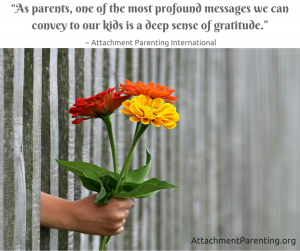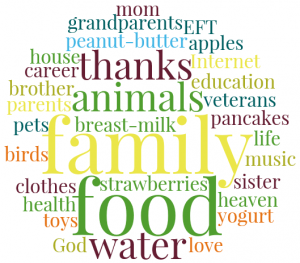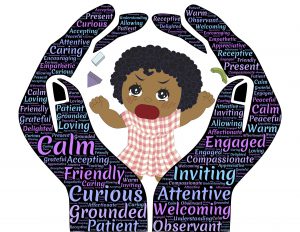 Every year, the Thanksgiving holiday gives us an opportunity to remember to give thanks for the blessings in our lives. API encourages you to make thanksgiving a daily practice. Learning to be grateful for even the most simple things in our lives can change us profoundly, creating overflowing capacity for joy and peace in both our individual lives and our parenting.
Every year, the Thanksgiving holiday gives us an opportunity to remember to give thanks for the blessings in our lives. API encourages you to make thanksgiving a daily practice. Learning to be grateful for even the most simple things in our lives can change us profoundly, creating overflowing capacity for joy and peace in both our individual lives and our parenting.
Gratitude is one of the most-written-about features of Attachment Parenting. Here are 10 tips on gratitude from APtly Said posts through the years:
- “Having a deep sense of gratitude benefits us in developing the ability to savor the pleasant moments in life and preserve through the painful ones.” ~ Effie Morchi, mother of 2 and API Assistant Editor, “Thankful kids“
- “I am grateful for many things big and small, grand and mundane. Today, it is the joyful shriek of my girls running in the twilight.” ~ Leyani Redditti, API Leader and mother of 2, “Gratitude“
- “There is an appreciation for all of us when we take the time to offer our thanks for something that happened during the day.” ~ Lisa Feiertag, API Leader and mother of 2, “Sharing gratitude on a nightly basis“
- “Learning to live a life of gratitude is like a ‘walking meditation,’ being present in the moment, not worrying about the past or the future but really living in the now, feeling intensely grateful for the many blessings we have in our lives.” ~ Lysa Parker, API Cofounder, mother, and grandmother, “Learning to live a life of gratitude“
- “Let’s start right here and right now by mindfully experiencing and expressing gratitude, even in the midst of what might sometimes look like a complete disaster.” ~ Inga Bohnekamp, mother of 1, “5 tips for mindfully coping with chronic illness, for your child and for you“
- “I know that I am so lucky to be a parent, and my days are peppered with gratitude as I watch my son laugh, play, or sleep — ordinary magic moments that make me so thankful.” ~ Yvette Lamb, mother of 1, “For Today, a poem for parents“
- “I feel the magic, love, gratitude, and magnitude in each moment. This love overwhelms me in the most powerful ways. I am truly thankful for being given the greatest role of my lifetime.” ~ Sandy Gordon Frankfort, mother of 2, “Are you afraid to admit the challenges you face as a parent?“
- “I honor each stage of your early development. How blessed we are to spend these days together. My heart fills with gratitude to your daddy who works long hours in the week to make this possible.” ~ Amy Wright Glenn, mother, “A day to live again“
- “Thank you, API, for giving me these wonderful gifts: joy in my parenting and peace in my life.” ~ Rita Brhel, API Leader, mother of 3, and API Executive Editor, “Thanksgiving for joy and peace in my parenting“
- “In awe, my son exclaimed, ‘Mama, the sky! It’s so colorful!’ I turned to him, and seeing his exuberant joy, my heart flooded with deep gratitude. To this day, years later, I still carry those words with me — my son’s gentle reminder to move a little slower, appreciate a little more, and pause long enough to enjoy the moments of delight our days have to offer us.” ~ Kendrah Nilsestuen, mother, API Leader, and API Education & Support Coordinator, “The sunrise of balance“














